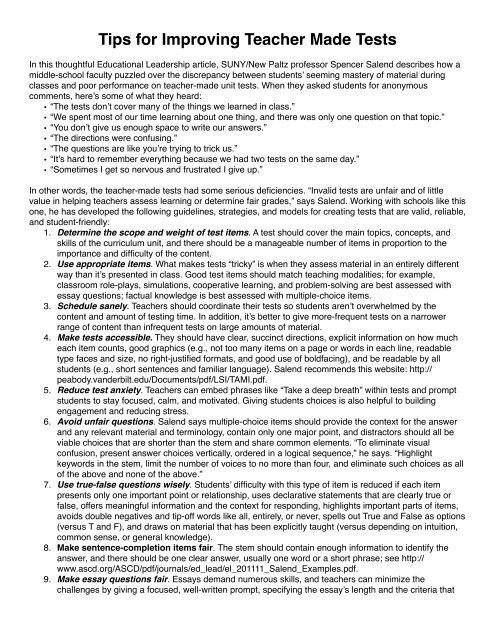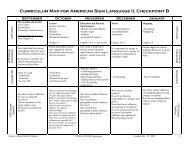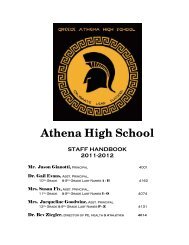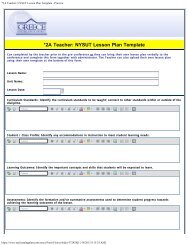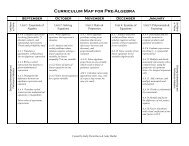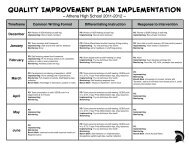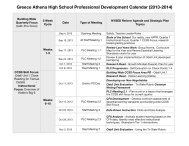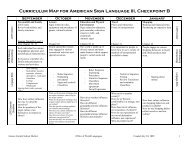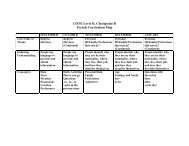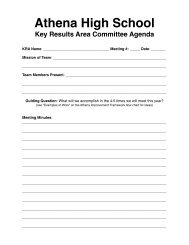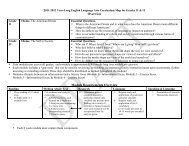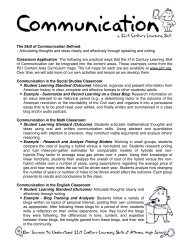Tips for Improving Teacher Made Tests (Research Summary)
Tips for Improving Teacher Made Tests (Research Summary)
Tips for Improving Teacher Made Tests (Research Summary)
Create successful ePaper yourself
Turn your PDF publications into a flip-book with our unique Google optimized e-Paper software.
<strong>Tips</strong> <strong>for</strong> <strong>Improving</strong> <strong>Teacher</strong> <strong>Made</strong> <strong>Tests</strong>In this thoughtful Educational Leadership article, SUNY/New Paltz professor Spencer Salend describes how amiddle-school faculty puzzled over the discrepancy between students’ seeming mastery of material duringclasses and poor per<strong>for</strong>mance on teacher-made unit tests. When they asked students <strong>for</strong> anonymouscomments, here’s some of what they heard:• “The tests don’t cover many of the things we learned in class.”• “We spent most of our time learning about one thing, and there was only one question on that topic.”• “You don’t give us enough space to write our answers.”• “The directions were confusing.”• “The questions are like you’re trying to trick us.”• “It’s hard to remember everything because we had two tests on the same day.”• “Sometimes I get so nervous and frustrated I give up.”In other words, the teacher-made tests had some serious deficiencies. “Invalid tests are unfair and of littlevalue in helping teachers assess learning or determine fair grades,” says Salend. Working with schools like thisone, he has developed the following guidelines, strategies, and models <strong>for</strong> creating tests that are valid, reliable,and student-friendly:1. Determine the scope and weight of test items. A test should cover the main topics, concepts, andskills of the curriculum unit, and there should be a manageable number of items in proportion to theimportance and difficulty of the content.2. Use appropriate items. What makes tests “tricky” is when they assess material in an entirely differentway than it’s presented in class. Good test items should match teaching modalities; <strong>for</strong> example,classroom role-plays, simulations, cooperative learning, and problem-solving are best assessed withessay questions; factual knowledge is best assessed with multiple-choice items.3. Schedule sanely. <strong>Teacher</strong>s should coordinate their tests so students aren’t overwhelmed by thecontent and amount of testing time. In addition, it’s better to give more-frequent tests on a narrowerrange of content than infrequent tests on large amounts of material.4. Make tests accessible. They should have clear, succinct directions, explicit in<strong>for</strong>mation on how mucheach item counts, good graphics (e.g., not too many items on a page or words in each line, readabletype faces and size, no right-justified <strong>for</strong>mats, and good use of boldfacing), and be readable by allstudents (e.g., short sentences and familiar language). Salend recommends this website: http://peabody.vanderbilt.edu/Documents/pdf/LSI/TAMI.pdf.5. Reduce test anxiety. <strong>Teacher</strong>s can embed phrases like “Take a deep breath” within tests and promptstudents to stay focused, calm, and motivated. Giving students choices is also helpful to buildingengagement and reducing stress.6. Avoid unfair questions. Salend says multiple-choice items should provide the context <strong>for</strong> the answerand any relevant material and terminology, contain only one major point, and distractors should all beviable choices that are shorter than the stem and share common elements. “To eliminate visualconfusion, present answer choices vertically, ordered in a logical sequence,” he says. “Highlightkeywords in the stem, limit the number of voices to no more than four, and eliminate such choices as allof the above and none of the above.”7. Use true-false questions wisely. Students’ difficulty with this type of item is reduced if each itempresents only one important point or relationship, uses declarative statements that are clearly true orfalse, offers meaningful in<strong>for</strong>mation and the context <strong>for</strong> responding, highlights important parts of items,avoids double negatives and tip-off words like all, entirely, or never, spells out True and False as options(versus T and F), and draws on material that has been explicitly taught (versus depending on intuition,common sense, or general knowledge).8. Make sentence-completion items fair. The stem should contain enough in<strong>for</strong>mation to identify theanswer, and there should be one clear answer, usually one word or a short phrase; see http://www.ascd.org/ASCD/pdf/journals/ed_lead/el_201111_Salend_Examples.pdf.9. Make essay questions fair. Essays demand numerous skills, and teachers can minimize thechallenges by giving a focused, well-written prompt, specifying the essay’s length and the criteria that
will be used to evaluate it, and giving students enough time to write. It might also be appropriate toallow students to refer to books and notes as they write.10.Monitor students’ per<strong>for</strong>mance and affect. Well-written tests should produce higher achievement andhappier, less-anxious students.Source: Creating Student-Friendly <strong>Tests</strong>” by Spencer Salend in Educational Leadership, November 2011 (Vol.69, #3, p. 52-58), http://www.ascd.org; Salend is at salends@newpaltz.edu.


